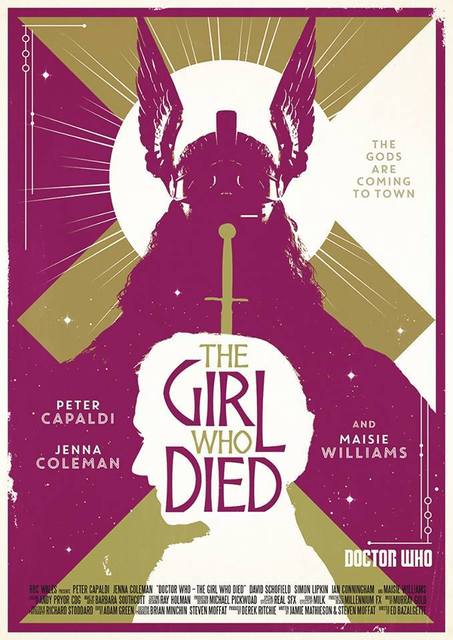
Aired 17 October 2015
‘The Girl Who Died’ finally brings Maisie Williams’s heavily publicized guest role to fruition, and although the story offered in the first thirty-five minutes featuring a Viking village battling against the robotic Mire is a solid one, it’s the last ten minutes or so that will surely be remembered in the long run.
From the start, it’s clear that the Doctor knows something about Ashildr, and those suspicions are confirmed as she comes back to life just moments after dying from heart failure. Casting a big name in Williams means that this turn of events will certainly have bigger ramifications in the long run- or at the very least in the next episode to close out the two parts. But her return to life brings with it several questions as well. First, Capaldi mentions that his face is a reminder, undoubtedly hearkening back to ‘The Fires of Pompeii,’ but what is it reminding him of exactly? Maybe more importantly, though, is the question of what the Doctor means when he calls her a hybrid. There has been a lot of talk about hybrids since Doctor Who returned to screens in 2005, but just a couple of episodes ago Davros mentioned a Gallifreyan prophecy regarding a hybrid of two warrior races, and this certainly could be related to that. It’s a different type of cliffhanger than usual, and not one that instantly puts anyone’s life in peril, but it’s just as effective and hopefully leads to a satisfying resolution.
There’s still the proper episode itself to get through, though, and that starts with the TARDS under attack and landing in a countryside full of angry Vikings. It’s quickly apparent that this is a much more light-hearted affair than many of the preceding episodes, and Capaldi gets a chance to flex his comedy muscles for the first extended period since ‘Robots of Sherwood.’ The comedic highlight of the episode is surely the Doctor pretending to be Odin- declaring that Gods never actually show up- only to have Odin appear in the sky above him. Even the training of the villagers in attack and defense techniques and the use of a yo-yo are situations full of humour, though, and the Doctor is clearly enjoying himself in a manner not often seen in this incarnation.
Yet still there’s the returning issue of what is going on with Clara. In this episode she declares that the Doctor is her hobby, more or less saying that she’s chosen to work on him since the passing of Danny. While it’s clear that these two still care a great deal about each other despite the Doctor’s snappy reaction, it feels as if Clara is stuck in a rut without any clear motivation to drive her narrative forward. Coleman is, as always, superb in the role, but at this point it almost seems as if she’s waiting for something bigger to happen to her. Following the dramatic upheaval she underwent in the previous series, it’s inevitable that she would flatten out a little bit as a character, but it’s disappointing that this far into the new series the writers have not yet found a fresh path for her to explore.
‘The Girl Who Died’ is not the most meaningful or emotional of Doctor Who episodes, but it is a funny and snappy story full of visually great Vikings and robotic Mire creatures that ultimately brings with it a lot of important questions. This feels more like a self-contained story rather than the opening half of a two-parter, but given the mostly reserved use of Maisie Williams’s Ashildr in this tale, it’s fair to assume that much bigger things are in store for her in the concluding ‘The Woman Who Lived’ and possibly beyond.


April 24, 2023
[…] M0vie Blog & II; Junkyard Blog I & II; Lyratek I & II; Random Whoness I & II; Doctor Who Reviews I & II; Who In Review I & […]